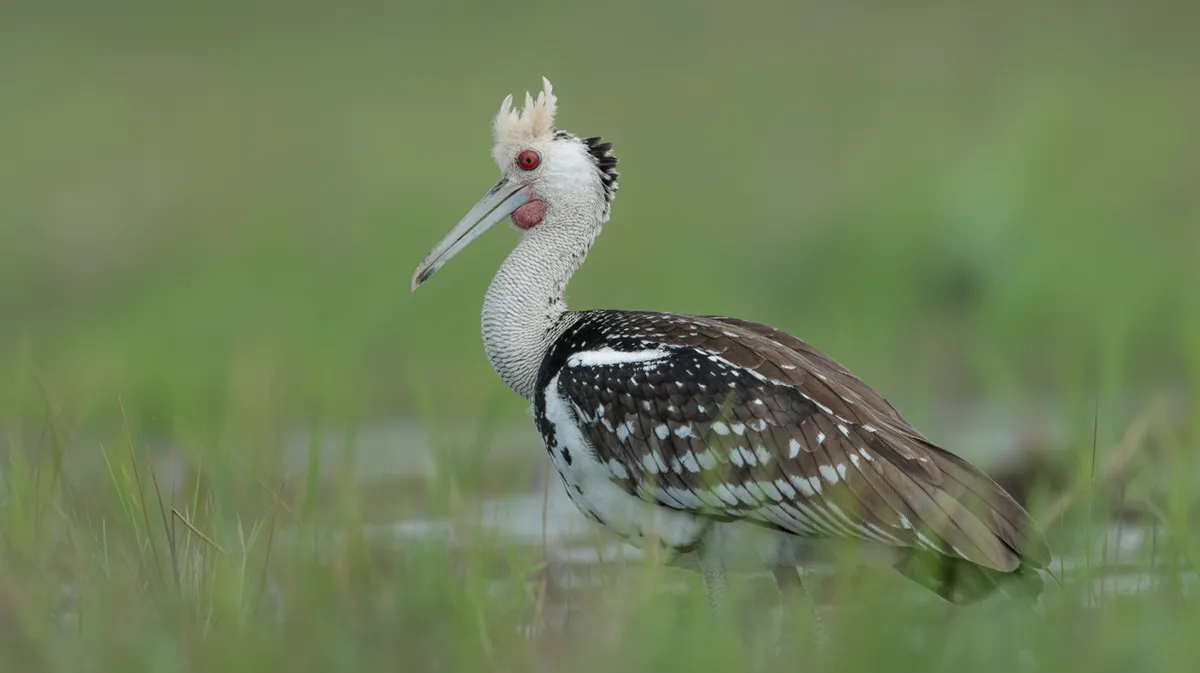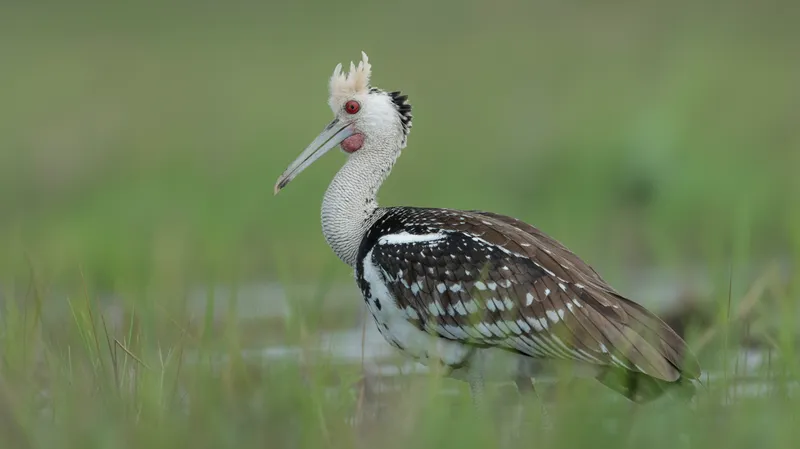
Horned screamer
Anhima cornuta

Meet the Horned screamer
The horned screamer is a large, distinctive bird native to the wetlands and marshes of northern South America. Its most striking feature is a long, slender, horn-like projection on its forehead, which is unique among birds. This species is known for its extremely loud, trumpet-like calls that can be heard over great distances, often echoing across its marshy habitats. Despite its intimidating appearance and name, the horned screamer feeds mainly on aquatic vegetation and is generally shy and elusive in the wild.
Classification
Bird
Habitat
Wetlands and marshes
Diet
Herbivore
Lifespan
10-15 years
Conservation
Least Concern
Weight
3-3.5 kg
📖Fascinating Facts
Unique Horn
The horned screamer’s 'horn' is a hollow, keratinous structure that can grow up to 15 centimeters long and is not attached to the skull.
Incredibly Loud Calls
They produce booming, trumpet-like calls that can be heard up to 3 kilometers away, helping them communicate across vast wetland areas.
Vegetarian Diet
Horned screamers feed mainly on aquatic plants and grasses, often pulling up roots and stems with their strong beaks.
📋Detailed Description
The horned screamer (Anhima cornuta) is a striking and unmistakable bird, measuring 84–95 cm (33–37 in) in length and weighing approximately 2.5–3.5 kg (5.5–7.7 lbs). Its plumage is predominantly black with a greenish gloss, contrasting with a white belly and distinctive white markings on the face and neck. The most unique anatomical feature is the long, slender, keratinous horn—typically 6–15 cm (2.4–5.9 in) in length—projecting from the crown, which is not a true horn but a cornified structure growing from the skull. The bill is short and chicken-like, unlike the flat bills of ducks, reflecting its specialized feeding habits. The wings possess two sharp, bony spurs at the carpal joint, which are used in territorial and mating disputes. The legs are long and robust, with partially webbed toes adapted for walking on floating vegetation. Horned screamers are highly vocal, producing resonant, far-carrying calls that serve both territorial and social functions. Despite their size and loudness, they are generally inconspicuous, moving slowly and blending into dense marsh vegetation. They are strong fliers, capable of covering considerable distances between feeding and roosting sites, but spend most of their time on the ground or in shallow water.
💡 Did you know?
Despite being large and noisy, horned screamers are excellent swimmers and often spend much of their time wading through water in search of food.
🔬Research & Sources
Wikipedia Summary
The horned screamer is a species of bird that belongs to a relatively small family, the Anhimidae, which occurs in wetlands of tropical South America. There are three screamer species, the other two being the southern screamer and the northern screamer in the genus Chauna. They are related to ducks, geese and swans, which are in the family Anatidae, but have bills looking more like those of game birds.
Last Modified: 5/25/2025
🎭Behavior & Social Structure
Horned screamers are diurnal and spend much of the day foraging in pairs or small family groups, occasionally forming loose flocks in areas of abundant food. Their diet consists almost exclusively of aquatic and semi-aquatic plants, including stems, leaves, and roots of water lilies, sedges, and grasses. Feeding is typically done by wading through shallow water or walking atop floating vegetation, using their strong toes for support. They are highly territorial during the breeding season, with pairs defending nesting sites using both vocalizations and physical displays, including wing-spurring. Outside of breeding, they may tolerate conspecifics in overlapping feeding territories. Screamers are generally shy and will retreat into dense vegetation if disturbed, but their loud calls are a constant presence in their habitat, especially at dawn and dusk.
👶Reproduction & Life Cycle
Horned screamers are monogamous, forming long-term pair bonds. Breeding occurs during the rainy season, which varies geographically but typically peaks between November and March. Nests are large, floating platforms constructed from reeds and aquatic plants, anchored in dense marshes or along lake margins. The female lays 2–7 white eggs, which are incubated by both parents for about 42–46 days. Chicks are precocial, leaving the nest within a day of hatching and following their parents, who lead them to feeding areas and provide protection. Both parents are highly attentive, and family groups remain together for several months. Fledging occurs at around 8–10 weeks, but juveniles may stay with parents until the next breeding season.
🛡️Adaptations & Survival
The horned screamer exhibits several unique adaptations for its wetland environment. The cornified horn, though not used in combat, may serve as a visual signal in social interactions. The bony wing spurs are used in intraspecific conflicts, particularly during territorial disputes. Their large, robust feet with partially webbed toes allow effective movement across floating vegetation and soft mud. The digestive system is adapted to process fibrous plant material efficiently. Their loud, far-reaching calls are facilitated by an enlarged, convoluted trachea, which acts as a resonating chamber. This vocal adaptation is crucial for communication in dense, visually obstructive habitats.
🎨Cultural Significance
In local folklore across the Amazon and Orinoco basins, the horned screamer's piercing calls have inspired myths, often being associated with spirits or omens due to their eerie, far-carrying nature. The bird is sometimes referred to as 'el unicornio' (the unicorn) in Spanish-speaking regions, referencing its unique horn. While not commonly hunted for food due to its tough flesh and strong odor, it is occasionally used in traditional medicine or as a curiosity. Its presence is often considered an indicator of healthy wetland ecosystems by indigenous communities.
🔬Recent Research & Discoveries
Recent research has focused on the phylogenetic position of screamers within Anseriformes, revealing that the family Anhimidae is an ancient lineage, diverging early from the ancestors of modern ducks and geese. Studies on vocalization mechanics have highlighted the role of the elongated trachea in sound production. Ongoing ecological studies are investigating the species' role in wetland plant community dynamics and its sensitivity to hydrological changes. Satellite tracking projects have begun to elucidate movement patterns and habitat use, providing data crucial for wetland conservation planning.
🎥Wildlife Videos

30 Strange Birds You Won't Believe Exist! | Wildlife Documentary | BBTV Official
In the most remote corners of our planet, there exist creatures so peculiar, so breathtakingly unique, that they almost defy belief.
BBTV Official

Northern Screamer, Colombia
Panama, Grand Cayman and Colombia are all visited on this special episode of Nikon's BATV. Join host James Currie as he ...
A WILD Connection

Let's meet the ... Horned screamer ( Anhima cornuta)
Is it a unicorn ? Is it a prehistoric kind of bird ? Watch the video and your questions will be answered .
Wildlife Channel

Creatures Of The Volcano
A million years ago, Italy was shaped by violent volcanic activity that created mountains and destroyed valleys in a lifeless world.
All Out Wildlife

Southern Screamer
Video by Bennett Hennessey. Although they are still common, Southern Screamers (and many other species of waterfowl) face ...
American Bird Conservancy

Friends of Rio & Amigos do Rio - Amazon Rainforest Walks - Horned Screamer August 2021
A sneak peak of my daily walks inside the Amazon Rainforest, Amazonas, Brazil. Watch our channel for camera traps & videos ...
Friends of Rio
🌍Habitat Information
The Horned screamer typically inhabits Wetlands and marshes environments. Horned screamers have adapted to their environments with specialized features and behaviors.
Primary Habitat:
Wetlands and marshes
More detailed habitat information will be available soon.
🛡️Conservation Status
The Horned screamer is currently classified as Least Concern. Conservation efforts are crucial for preserving this species for future generations.
Common Threats:
- 🏠Habitat loss and fragmentation
- 🌡️Climate change impacts
- 🎯Hunting and poaching
- 🏭Human-wildlife conflict
⚠️Threats & Conservation Challenges
Currently classified as Least Concern by the IUCN, the horned screamer's population is considered stable, though localized declines have been reported due to habitat loss. Major threats include wetland drainage, conversion of marshes to agriculture or pasture, and pollution. In some regions, hunting and egg collection pose additional pressures. Despite these threats, the species' wide distribution and adaptability to various wetland types have buffered it from severe declines. Continued habitat degradation and climate change, however, could pose future risks, particularly in fragmented populations.
🔬Scientific Classification
Scientific Name
Anhima cornuta
Classification Hierarchy
🔍 About Taxonomic Classification
Taxonomic classification is a hierarchical system used by scientists to classify and organize living organisms based on shared characteristics and evolutionary relationships.
The system moves from broad categories (Kingdom) to increasingly specific ones, with each animal's scientific name typically consisting of its Genus and species.
📝Community Notes
Share your observations and insights about the Horned screamer with our community of wildlife enthusiasts.
Join Our Community
Sign in to share your observations and connect with fellow wildlife enthusiasts.
Sign In to ContributeNo community notes yet
Be the first to share your observations about the Horned screamer!
Explore Horned screamer
Select a tab above to learn more about this amazing animal.
📸Photo Gallery
No photos available for this animal yet.
🌟Discover More Wildlife
Continue your journey of discovery with more fascinating animals from our database
